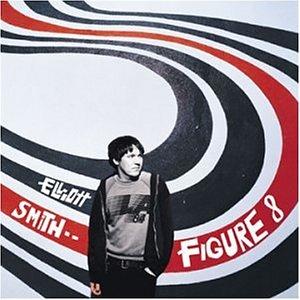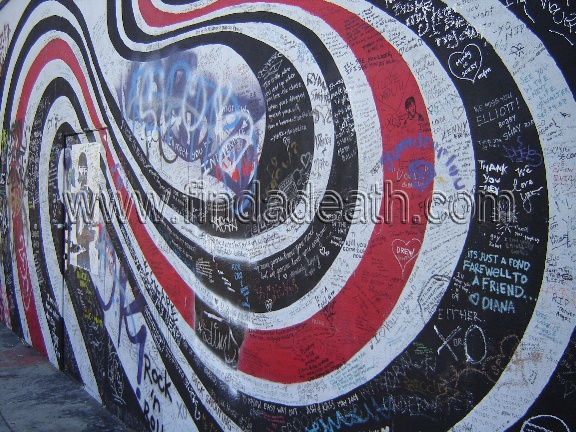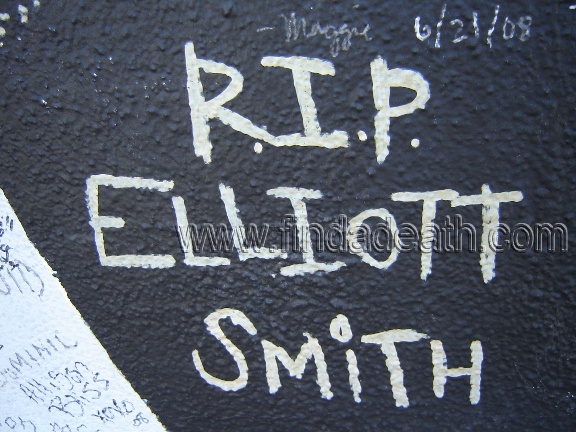August 6, 1969 – October 21, 2003

By Joe Novotny
Steven Paul Smith was born in Omaha, Nebraska on August 6, 1969 to Gary Mac Smith and Bunny Kay Berryman. He had an unsettled childhood – Berryman divorced her husband and moved to Duncanville, Texas (near Dallas) with little Steven. Dad moved to Portland, Oregon and became a psychiatrist. Mom remarried to Charles Hugh Welch when Smith was 4. Smith took to music when he was in elementary school and won a local competition for a piece he composed on the piano. Later he played clarinet in his junior high band. In the 6th grade he got his first guitar, trying out songs by Pink Floyd, the Beatles and he even mastered “Amazing Grace”. Smith would later recall his time in Texas as bleak, as he was often getting into fights. He became well-versed in classic rock like The Who and Rush, but expanded his tastes to Peter, Paul & Mary and the Clash.
Because of a rocky and abusive relationship with his step-dad, Smith moved to Portland to be with his father, Gary. At this time, he started a band and wrote one of his first songs, “Condor Ave.”, which would eventually appear on his first solo LP, Roman Candle. Smith ended up in Amherst, Massachusetts at Hampshire College. He renamed himself “Elliott”, initially as a joke, but the name stuck since he felt it was less “jock-ish”. He became friends with a more sensitive, diverse crowd of people. It was an attempt to escape the knucklehead mentality he had been around in high school as well as back in Texas. Some of his new friends were gay, including buddy Neil Gust. When they graduated, they moved to Portland and began the band Heatmiser. In the early 90’s, it was somewhat novel to hear gay punk/indie rock, but the band achieved modest success. Soon it became apparent that Smith’s songwriting was growing by leaps and bounds. The band split up.
It wasn’t long before Smith had a loyal following and had made a name on his own. By the time of his third LP Either/Or, he was garnering national attention for writing music that was intensely passionate, intimate, and heartfelt. He moved to Park Slope, Brooklyn, where some say he began a rough period. He was abusing alcohol, and friends alternately recall a happy, fun Smith and others saw a darker, more helpless side. He lived on the edge, at times walking around subway tunnels at night or passing out in Central Park after going on a particularly rough bender.
In late 1997, Smith was recording his first LP for the Dreamworks label, and he got word that the song “Miss Misery” (which he had written for the movie Good Will Hunting) had been nominated for an Academy Award for Best Original Song. The only problem was that he was going up against Sea lion Dion for “My Heart Will Go On”. He didn’t have a shot, but he performed live at the ceremony anyway. At a certain point, he and fellow nominees Dion and Trisha Yearwood appeared on stage together and took a bow. For his fans, it was a tremendous disconnect from the Smith they thought they knew. When asked about the experience, Smith simply couldn’t believe that people were expecting him to be so far removed from the other nominees. Regarding Dion, he remarked “she’s SO nice!”.
From 1998 and on, it became clear that even though Smith was hitting an artistic peak, he was also delving into some very dark thoughts. Friends got increasingly frustrated with his erratic behavior. Through multiple tours and a highly acclaimed album namedXO, Smith flirted with heroin use, which he had always alluded to in songs older songs like “The White Lady Loves You More” and “Needle in the Hay”. In the 2001 movie The Royal Tenenbaums there’s a chilling scene where Luke Wilson’s character Richie Tenenbaum attempts suicide while “Needle in the Hay” plays, an eerie foreshadowing of what was to come in Smith’s own life.
In 2000 Smith released what is arguably his masterpiece, Figure 8. Though it was received fairly well, it didn’t quite translate with fans that appreciated Smith’s more sparse and intimate acoustic songs. Figure 8 was a fully realized record with well-constructed harmonies, a full band, and rich production. The lyrics were cryptic, but it was a record that fully fleshed out Smith’s melodies and vision of how grandiose his songs could sound. He had accomplished his Sgt. Pepper. At the beginning of 2000, he did an acoustic tour and appeared relatively healthy, perhaps a little bloated. By autumn, he was touring the U.S. for a third time and was hardly recognizable. He was gaunt, had grown rough facial hair, wore a ski hat and looked like a person removed from his former self. To top it off, he was closing his sets with a letter-perfect cover version of “Don’t Fear the Reaper” by Blue Oyster Cult. It didn’t appear as though Smith was in a good place.
During the final years of his life, Smith hit rock bottom. Addicted to crack, heroin, and alcohol and abusing other substances, he took up residence in Los Angeles. Friends from Portland lost contact with him, and hence the last few years were rather mysterious to many. They knew that he was in a bad place, and Dreamworks even attempted an intervention. Smith did not receive the offer for help warmly and he backed away from the label in defiance. In 2001, after a bizarre and inconsistent performance at the Sunset Junction Music Festival in Silver Lake, CA, word was actively spreading amongst Smith’s fan base that his behavior was strange and perhaps fueled by drugs.
Smith was working on an LP with the working title Basement on the Hill and became involved with art therapist/musician Jennifer Chiba. They had known each other for a few years, but Smith had been courting her and they soon moved into a house on Lemoyne Street in LA’s Echo Park.

I believe these are the windows to his place.

No doubt, several bottles have seen the bottom of these bins.

Around this time Smith had taken drastic measures to overcome his addictions, and he completed a stint in rehab at the Neurotransmitter Restoration Center. It appeared as though he had turned a page and the worst was over. He was actively writing and recording songs. Like many volatile and troubled rock stars before him, Smith still felt he was in a battle. In late 2002 he was arrested in a confrontation with a police officer at a Beck/Flaming Lips concert in Universal City. He was standing up for some kids that he felt were being intentionally roughed over by cops, and something in him snapped. The incident haunted him for months. He fought charges to avoid jail time as he tried to complete his LP, which was not going to be released on Dreamworks.
On October 21, 2003, at 12:18 p.m. a call was placed to 911 from the house on Lemoyne Street. According to the coroner report, Chiba and Smith were having an argument and she locked herself in the bathroom. She heard Smith let out a scream, and came out to find him with his back to her. When he turned around she saw a knife sticking out of his chest, which she removed and later claimed that two cuts could be seen in his chest. He walked away, collapsed, and at that point Chiba called 911. She attempted to perform CPR and first aid until paramedics arrived. Smith was still living at this point and taken to the hospital while Chiba was questioned by police at the house. While seated at the kitchen table she noticed a “post-it” note with the words “I’m so sorry-love, Elliot. God forgive me”. Chiba claimed she recognized the handwriting as that of Smith’s.
Smith was pronounced dead at LAC/USC Medical Center at 1:36 p.m.

He had two stab wounds to the chest, the second was the one thought to be fatal. Though doctors tried to repair the lacerations, he did not respond to resuscitation efforts. They also found what were thought to be defensive wounds on his arms. Smith had two tattoos, one of a bull smelling a flower on his right arm, and the State of Texas surrounded by a circle with saw tooth edges on his left shoulder. His toxicology report was clean but noted the presence of Adderall and Strattera (used to treat attention deficit hyperactivity disorder) and Remeron (anti-depressant). Smith was wearing a black Mick Rock t-shirt. Though he had supposedly attempted suicide previously (it is not known when and where) and had a history of depression, only the direction and location of the stab wounds were consistent with self-infliction. What raises the question of homicide is the absence of hesitation marks, the fact that he was stabbed through clothing, the presence of what are likely defensive wounds, and then detectives grew suspicious when Chiba initially refused to talk to them. Eventually she conceded that Smith had suffered from depression all his life and would engage in self-mutilating behavior. Sometimes he would burn himself with cigarettes. At a later point, Chiba gave an interview to the L.A. Times to tell her side of the story. Despite the case still being open, it has still not been determined if Smith’s death was caused by suicide or homicide.
The news of Smith’s death stunned his fans. Fellow musicians Beck, Sleater-Kinney, Death Cab for Cutie and others paid tribute to him. Those that appreciated his music woke up the morning of October 22nd and reacted to the news, shocked and saddened beyond words. Smith was cremated and the whereabouts of his ashes are unknown. He had been photographed in front of the mural at Solutions Audio-Video Repair at 4334 W. Sunset Boulevard in Los Angeles for the Figure 8 album cover (above), and after his death it became a site where fans paid tribute and wrote messages.

There were memorials in New York, Los Angeles and Toronto, with tribute concerts in Los Angeles, Boston, Omaha, and lots of other cities in the months following Smith’s death.
While a musician like Kurt Cobain was surrounded by a tremendous amount of fame, controversy, and scrutiny, Elliott Smith never achieved that level of success and therefore his image and persona were never as tainted by infamy. Knowing Smith happened to a greater degree by personal discovery as opposed to media filter. While much mystery surrounds his death, it never seems to overshadow the incredible impression of artistic contribution he made through his music. Anyone lucky enough to see Smith in concert can recall not just his music, but the times when he would crack a joke with the audience, attempt to perform a requested song, or demonstrate the playful side of him that would balance out the personal nature of his lyrics and the intensity of his music.
By many accounts, friends could see the great sides of Smith’s personality in the happy moments they had shared, others got a glimpse of a darker side. It was probably his ability to go back and forth that made his music so easy for people to relate to. He was willing to contrast the light and dark of life, the beauty against the ugliness, the sacred and the profane. The authenticity of his art is ultimately what people will probably keep discovering many years from now. Those that knew Smith insist he wasn’t all doom and gloom, even though the honesty of his songwriting suggested he had many demons to shake off. Like so many before him, the fact that he had finally come clean and started down a more sane path in life may have been too much for his spirit to handle. In the end, one really needs to look no further than his prodigious output of work to see the genuine Elliott Smith.

Wanna see his mailbox?

Thanks, Joe, and thanks C.

You did a helluva job with this write up Joe Novotny. Your love and passion for Elliotts music definitely shows. Kudos.